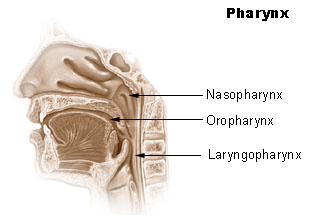Part I – The Pharynx
(Resonating since the dawn of time…)

SR2: Quoting from William Vennard’s “Singing: The Mechanism and the Technic“, p. 92, 335:
“The pharynx, when it is large enough, strengthens the lower partials of the voice, giving it mellowness and fullness. It is likely that when singers think they are “adding chest resonance,” they are really adding heavy registration, resonated by a deeper pharynx.”
It goes on to say that the resonating frequencies of the pharynx are 330-750Hz (several authors indicate different ranges, but this is the entire range from all of them). From the examples of basses and my own personal experience, it is possible that one can learn to open up the pharynx with more space and free it from constrictive tension to create fullness in the voice, specifically with the lower pitches. Listening to myself with subharmonics, the pharynx makes even more sense when connecting it with full voice – the pharynx does not change. Since you are essentially adding a “layer” of fry with full voice in subharmonics, the tendency is to press down and focus; if you remember in an earlier post, I called subharmonics an “open vocal fry” – at first, I was going by what I was feeling when singing subharmonics, but this passage that Vennard writes confirm it. If you want that smooth transition, do something with your pharynx – it is pretty much the most important resonator affecting your tone quality.
Here is an example of vocal fry with a thin sound (using only the edge of the folds, very relaxed with no modification of the pharynx) – at about 0:34, I move toward a deeper, larger pharynx:
This is very easy on the voice and has enough sound to be present in a choir with a pyramid of sound (sopranos – pp; altos – p; tenors – mp; basses – mf or louder). Many contemporary basses capitalize this sound using microphones and sound reinforcement. Some have also labeled this sound as a fry/chest mix where the vocal fry carries more chest resonance to sound fuller.
Initial efforts of vocal fry usually constricts the pharynx as you can hear in the example above, which is why it sounds thin. Those that have developed it actually may have developed a way to remove that constriction, opening up and freeing the pharynx to create that fullness we hear in what we call “chest voice” or a fry/chest mix. Unlike subharmonics or full voice, however, the voice still contains the bubbling sound in vocal fry since the folds are still slack and short as well as in a state of full adduction (only puffs of air bubbling through, creating clicks/pulses that approximate the low note); a full wave from one end of the folds to the other end is not realized. With a good pharynx at play, though, it does make it harder to distinguish between “chest voice” (where the folds are thick and short, but allowed to vibrate freely and create a complete oscillation of the lower note being sung) and a “fry/chest mix” – being able to distinguish between the two is not impossible (double negative), of course.
Singers with really good ears and those with contra-octave experience in classical music or genres where there are no handheld mics (or being very closely miked) can hear and distinguish the “bubbles” in fry vs. the “complete oscillation” in full voice. Processed voices (EQ, compression, etc.) can add fullness as well and remove “wooly” or fuzzy sounds from fry if needed which further confuses the topic at hand. I use an Electro-Voice ND767a (what a deal, some of them are going for about 80 bucks only, I bought mine brand-new for 130 bucks…) for singing anything a cappella on mic – it is such a great mic and is made for lower voiced singers (response down to 35Hz, which is between a C#1 and a D1). I will say, though, that the bass singer still has to have something really going on in the contra-octave for any of the digital effects to work (unless you replace the voice with a subharmonic synthesizer… which is a different topic…)
Here is one of my favorite gospel basses, George Younce, with The Cathedrals singing “Movin’ Up To Glory Land” – ranging from G1 to B4 for the bass voice with lots of D2s and C2s (and with everyone on an EV ND767a, too!):
Check out deals on an EV767a Mic on Ebay.com!
This may also answer some of our questions recently regarding the development of the voice. With age (actually, experience primarily), one can develop the pharynx to create this fullness we seek as basses (full or fry) in addition to thicker folds, better technique, and settling of the voice from age.
I am not sure at this point, but I do feel that the maturity and settling of the voice also affects this part (pharynx) of the resonance in the voice (as well as other resonances in other places of the voice); we can clearly hear the changes in Vladimir Miller’s voice from past to present recordings, which is a testament to his voice and development as a profundo. Other singers on the Octavism Facebook Page find this to be true in their own experiences as well.
So, get those notes down, work on that range, create awesome tones, and when you need it, falsetto and subharmonics are there for you… like Friends. 😀
On a side note, it has been a great summer and it’s great to be back. Enjoy octaving. Live like a basso. Keep singing. Thank you for supporting this site by clicking on the affiliate links above and buying products (no extra cost to you). 😀
– Thou

